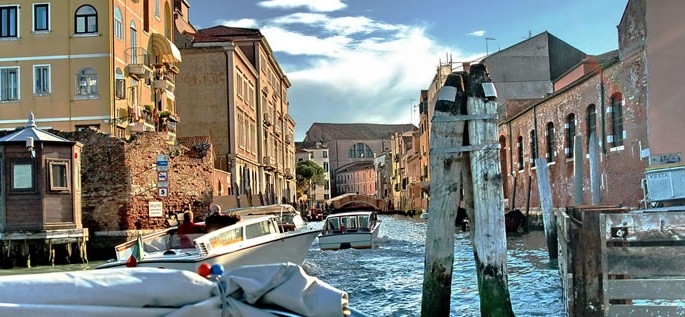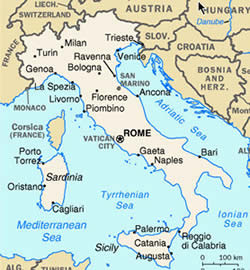
Italian
Italian belongs to the Romance branch of the Indo-European language family. Like the other Romance languages, it is a descendant of Vulgar Latin spoken by the Romans and imposed by them on the peoples under their rule. 
Status
Italian is the national, or de facto national, language of Italy, San Marino, Vatican City, Switzerland, and some areas of Slovenia and Croatia. It is widely spoken in Malta, Corsica, Albania, Luxemburg, Germany, and Belgium. In the Americas, it is spoken in the United States, Canada, Venezuela, Uruguay, Brazil, and Argentina.
Click here on the MLA Interactive Language Map to find out where Italian is spoken in the U.S.
Dialects
Italian dialects form a continuum of intelligibility, with the geographically distant ones being mutually unintelligible. In modern Italy, people communicate mostly in regional dialects, although standard Italian is the only written language. It is estimated that about half of Italy’s population does not speak standard Italian as a native language. Most speakers of the dozens of regional Italian dialects come in contact with standard Italian in elementary school.
The proliferation of regional dialects in Italy is due to its long history of separation into many small states and colonization by France, Spain and Austria-Hungary between the fall of the Roman Empire and Italian reunification in 1861. During this period, the official language of most Italian states was either Latin or the language of the colonizing power.
During the 14th century, the Tuscan dialect began to predominate because of the central position of Tuscany in Italy, and because of the economic power of its most important city, Florence. It was not until the 19th century, however, that the language spoken by educated Florentines spread to become the standard language of a newly unified Italy. With progressive increases in literacy, standard Italian became gradually accepted as the national language in the 1950s.
Structure
Sound system
Like all Romance languages, Italian has a fairly uncomplicated sound system. All words, with the exception of some borrowings, end in a vowel. Initial two-member clusters are limited to Consonant + /r/ or /l/ or /s/ + Consonant. There are a few /s/ + Consonant + Consonant clusters.
Vowels
Italian has 7 vowel phonemes, i.e., sounds that make a difference in word meaning. Vowels are short, if not under primary stress, and long in stressed syllables that end in a vowel. Final vowels are always short.
|
i
|
u
|
||
|
e
|
o
|
||
| Open-mid |
ɛ
|
ɔ
|
|
|
a
|
- /i/ = beet
- /e/ = bait
- /ɛ/ = bet
- /a/ = bat (some dialects)
- /u/ = boot
- /o/ = boat
- /ɔ/ = bog
Consonants
Italian has 24 consonant phonemes, i.e., sounds that can differentiate word meaning. A distinguishing feature of most Italian consonants is gemination, or length. Consonant length makes a difference in word meaning. Geminate stops and affricates have a lengthened closure; geminate fricatives, nasals, and /l/ have a lengthened duration; geminate /r/ is realized as a long alveolar trill. A few examples include: agio ‘ease’ and aggio ‘premium’, casa ‘house’ and cassa ‘box’, sera ‘evening’ and serra ‘greenhouse’, nono ‘ninth’ and nonno ‘grandfather’.
| Stops | voiceless |
p
|
t
|
k
|
|||
| voiced |
b
|
d
|
g
|
||||
| Fricatives | voiceless |
f
|
s
|
ʃ
|
|||
| voiced |
z
|
||||||
| Affricates | voiceless |
ts
|
tʃ
|
||||
| voiced |
dz
|
dʒ
|
|||||
| Nasals |
m
|
n
|
ɲ
|
||||
| Laterals |
l
|
ʎ
|
|||||
| Trill |
r
|
||||||
| Approximants |
w
|
j
|
- /p, t, k/ are not aspirated, i.e., they are produced without a puff of air, as in English.
- /ʃ/ = sh in shop
- /tʃ/ = ch in chat
- /dʒ/ = j in job
- /ɲ/ = first n in canyon
- /ʎ/ = ll in million
Stress
Stress in Italian words is free and variable, i.e., it can fall on any syllable in a word.
Grammar
Italian grammar is Latin-based and, therefore, shares most of its basic features with other Romance languages such as French, Spanish, and Portuguese.
Nouns, adjectives, articles, and pronouns
- Italian nouns are marked for gender (feminine and masculine), and number (singular and plural). Most masculine nouns end in -o, and most feminine nouns end in –a. There are some exceptions.
- Adjectives agree with the nouns they modify in gender and number.
- There are a definite and an indefinite article which agree with the noun in gender and number, e.g. la ragazza ‘the girl’ — le ragazze ‘the girls’, il cane ‘the dog’ — i cani ‘the dogs’.
- Nouns and adjectives are not marked for case, but pronouns have retained some of the Latin cases.
- There is an extremely productive system of affective suffixes relating to size and to the speaker’s attitude towards the person or object in question, e.g., ragazzo ‘boy’, ragazzino, ragazzetto, ragazzuccio ‘little boy’; ragazzone ‘big boy’ and ragazaccio ‘bad boy’.
- Standard Italian distinguishes between 2nd person pronouns, i.e., familiar tu and formal Lei.
Verbs
- Italian verbs are marked for person (1st, 2nd, 3rd) and number (singular, plural). They agree with their subjects in person and number.
- Subject pronouns are usually dropped since the verb ending carries information about person and number.
- There are two conjugations and many irregular verbs.
- There are four moods: indicative, imperative, conditional, subjunctive, and imperative.
- The indicative mood has four simple and four compound tenses. Compound tenses are formed with the auxiliary verb avere ‘to have’.
- The infinitive usually ends in –re, e.g., leggere ‘to read’.
- The imperative has two forms: informal and formal.
- The conditional has a present and a past form.
- The subjunctive has 2 simple and 2 compound forms.
Word order
The normal word order in Italian sentences is Subject-Verb-Object. Adjectives can either precede or follow the nouns they modify.
Vocabulary
Italian vocabulary is mainly derived from Latin, with numerous borrowings from Greek, French, German and English. Below are a few common words.
| Hello | Ciao |
| Good bye | Arrivederci, addio, ciao |
| Please | Per favore |
| Thank you | Grazie |
| I am sorry. | Spiacente, scusa, scusi |
| Yes | Sì |
| No | No |
| Man | L’uomo |
| Woman | La donna, la femmina |
Below are the numbers 1-10 in Italian.
|
1
|
2
|
3
|
4
|
5
|
6
|
7
|
8
|
9
|
10
|
|---|---|---|---|---|---|---|---|---|---|
|
uno
|
due
|
tre
|
quattro
|
cinque
|
sei
|
sette
|
otto
|
nove
|
dieci
|
Writing
The early texts, reflecting the spoken language of Italy, were written in regional dialects.The first Latinized text of unknown origin probably dates from the 8th century. Several documents from the 10th-11th centuries are more surely written in Italian. The first literary work dates to the late 12th century, and the first poetry written in a Sicilian dialect goes back to the 13th century.
Modern Italian is written with the Latin alphabet.
|
A a
|
B b
|
C c
|
D d
|
E e
|
F f
|
G g
|
H h
|
I i
|
L l
|
M m
|
|
N n
|
O o
|
P p
|
R r
|
Q q
|
R r
|
S s
|
T t
|
U u
|
V v
|
Z z
|
- The letters j, k, w, x, y are used only for spelling foreign borrowings, and are not considered part of the regular Italian alphabet.
- gl = ll in million, e.g., figlio ‘son’ is pronounced as [filyo]
- gn = first n in canyon, e.g., gnocchi ‘potato dumplings’ is pronounced as [nyokki].
- h is always silent
- Italian uses the acute accent over the letter é, and a grave accent over any stressed vowel at the end of words, e.g., dignità, ‘dignity’.
- c is pronounced as [ch] before the vowels e and i, e.g., ciao ‘hello’ is pronounced as [chao].
Take a look at Article 1 of the Universal Declaration of Human Rights in Italian.
| Dichiarazione universale dei diritti umani Articolo 1 Tutti gli esseri umani nascono liberi ed eguali in dignità e diritti. Essi sono dotati di ragione e di coscienza e devono gire gli uni verso gli altri in spirito di fratellanza. |
| Universal Declaration of Human Rights Article 1 All human beings are born free and equal in dignity and rights. They are endowed with reason and conscience and should act towards one another in a spirit of brotherhood. |
Did You Know?
English has borrowed many words from Italian. Below is a sampling from three different categories of borrowings.
|
Musical terms |
Foods |
Miscellaneous |
|---|---|---|
|
adagio |
al dente broccoli lasagne linguini macaroni (from maccheroni) pasta pizza spaghetti zucchini |
al fresco bimbo fiasco ghetto mafia stucco studio umbrella graffiti |
Difficulty
 How difficult is it to learn Italian?
How difficult is it to learn Italian?Italian is considered to be a Category I language in terms of difficulty for speakers of English.